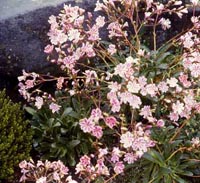Resource Library
Plant of the Week: Bitterroot, Lewisia
The University of Arkansas System Division of Agriculture does not promote, support or recommend plants featured in "Plant of the Week." Please consult your local Extension office for plants suitable for your region.
Plant of the Week
Bitterroot
Latin: Lewisia rediviva

For a story to take on a life of its own, it must have a good plot, adventure and a little romance thrown in for good measure. The Lewis and Clark expedition of 200 years ago fits these criteria and, because of it, remains one of the most cherished tales of American history.
Meriwether Lewis (1774 - 1809), an Army officer and personal secretary to President Jefferson, was no botanist. But Jefferson, ever curious about the natural world, instructed Lewis to collect new vegetation.
Lewis did remarkably well as a plant collector, returning with about 200 specimens, all gathered on the return trip.
One of these plants he met going and coming. On their way west his advance scouts happened upon a party of Shoshone Indians as they rested near the Continental Divide in what is now Montana. The sudden arrival of the scouts spooked the natives, causing them to leave behind a basket of dried roots they had with them.
These were taken to Capt. Lewis, who boiled them in water and judged two of the three roots agreeable. The third, a small white root of a plant later named Lewisia rediviva, had a bitter, disagreeable flavor. Though Lewis didn’t like the taste, it was this species that was to immortalize Lewis in the botanical world.
A year later on July 2, 1806, as the expedition was returning from the Pacific, Lewis spied the plants in flower at the campsite known as "Travelers Rest" near present day Missoula. Near camp, he collected several plants new to him. One of these was the bitterroot that was then producing its large, solitary pink blossom atop a 2-inch tall leafless plant.
The genus Lewisia was established by the German-born botanist Frederick Pursh (1774 - 1720). Pursh arrived in Baltimore in 1799, apparently as a self-educated gardener and an aspiring botanist. In 1803, he moved to Philadelphia and became acquainted with the botanical luminaries of that city, eventually being hired to collect plants for a planned flora of the United States.
When Lewis arrived in Philadelphia with his dried cargo of plants, he first took them to Bernard McMahon, a nurseryman and friend of Jefferson. McMahon germinated the seeds Lewis had collected and snipped a dried root of bitterroot from the year-old specimen Lewis was carrying. It grew, but the plant never flowered.
McMahon introduced Lewis to Pursh, and he was sufficiently impressed with the man that he turned most of his dried plant specimens over to him. Pursh was to classify the plants and write technical descriptions of the material. After Lewis’ apparent suicide in 1809, the botanical project went seriously off course.
Pursh had drifted to New York on another flora project, leaving what was believed to be the majority of the plant collection behind in Philadelphia. Capt. Clark asked a Philadelphia botanist to complete the task, but he never got around to it. In 1811, Pursh moved to London where it was discovered he had maintained duplicate samples of the plants or snipped off bits and pieces when only one specimen was preserved.
So, to the chagrin of the fledgling American scientific community, the plants of the Lewis and Clark expedition finally were published in 1814 by a German living in England.
Pursh ended up naming some 140 new genera, about 40 of which are still recognized as valid.
Unfortunately for eastern gardeners, bitterroot is almost impossible to grow. One west coast nurseryman that offers it in his catalog says of it "a challenge for even the experienced horticulturist."
The hybrid Lewisias that are occasionally seen in nurseries are selections of the fleshy leafed Lewisia cotyledon. While considered easier to grow, it too is a challenge in our overly wet and overly warm eastern climate.
By: Gerald Klingaman, retired
Extension Horticulturist - Ornamentals
Extension News - February 11, 2005
The University of Arkansas System Division of Agriculture does not maintain lists of retail outlets where these plants can be purchased. Please check your local nursery or other retail outlets to ask about the availability of these plants for your growing area.